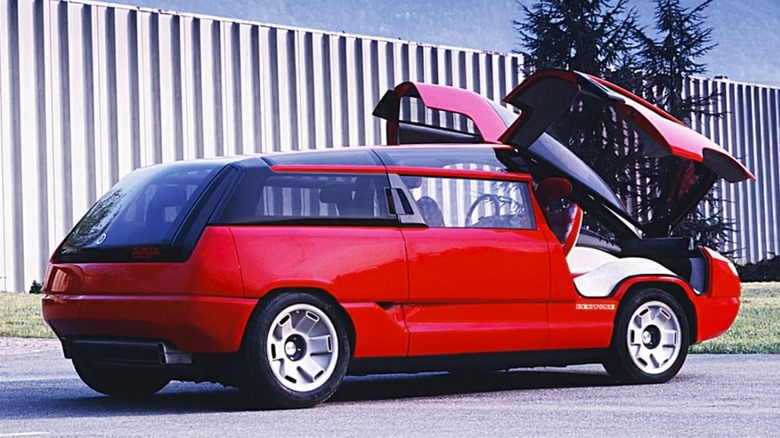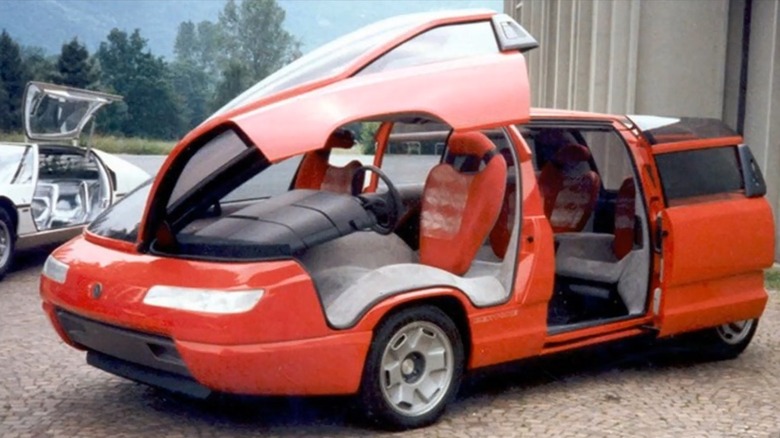This Bizarre Lamborghini Powered Concept May Be The Coolest Minivan Ever Made
At the 62nd annual Turin International Motor Show in 1988, automakers were trumpeting the "one-box" vehicle design from the rooftops. While it mainly applied to minivans, the prevailing thought was it could be utilized on everything from stretch limousines to ultra-fast supercars (via Autoweek).
Lamborghini unveiled its Bertone-designed Genesis minivan concept based on that one-box blueprint. Motor1 comically likened the odd design to a "massive greenhouse," and they weren't altogether wrong, because the thing was well over 14 feet long and nearly seven feet wide (via Below the Radar), and weighed almost two tons (via Motor1). Despite looking like a giant piece of Good & Plenty candy, Lamborghini didn't want people to think of the Genesis as a minivan, but a "logical evolution of today's Countachs and Ferrari F40s" (via Autoweek).
At the time, the Italian sports car maker was owned by Chrysler (via Motor1), and Lee Iacocca, who was president and chairman of the board for Chrysler at the time (via Britannica), was lavishing Lambo with Scrooge McDuck-type money and wanted them to build their own minivan (via Hagerty). After all, Chrysler had basically invented the whole category to begin with, which Iacocca was famously a part of (via MotorCities).
So Lamborghini and Nuccio Bertone, designer of the iconic Countach, went to work on fixing what he perceived were the deficiencies of the outdated supercar, such as poor visibility, claustrophobic interior, and the difficulty getting in and out of the thing (via Autoweek).
The one-box Genesis had the wings to fly
While the interior was spacious, seating highlighted comfort over practicality. After all, this was a "super" van, not a soccer mom's kid cab. There was room for only four passengers (plus the driver), but each got ample legroom and their own Alcantara leather bucket seat that could power-adjust/slide/fold in different ways. The three front seats all spun 180° to face the person behind them (via MotorBiscuit), while the two rear seats even had leg rests (via Motor1).
The driver and front passenger seats were unusual in that they both sat directly over the front axle in an almost-reclining position that put their feet near the front of the Genesis' nose. The driver and front passenger entered the vehicle through huge gullwing doors, while rear passengers entered via sliding doors on either side of the main cabin.
The "first-class" interior aside, the biggest kick to convention came from the Countach engine. The "bump" sitting between the front seats is the engine. In fact, it's the same 5.2-liter V12 engine used in Lamborghini's Countach 5000 Quattrovalvole strapped with six Weber carburetors (via MotorBiscuit) that produced 455 horsepower, and had a top speed of 155 mph (via Petrolicious). The Genesis had a three-speed TorqueFlite automatic transmission instead of the five-speed manual in the Countach (via Motor1).
It took Bertone and his team some 30,000 hours to design and build the one-off concept Genesis (via Motor1). While it never went into production, Automotoclub Storico Italiano purchased the minivan when Bertone filed bankruptcy and frequently takes it to auto shows (via MotorBiscuit).

